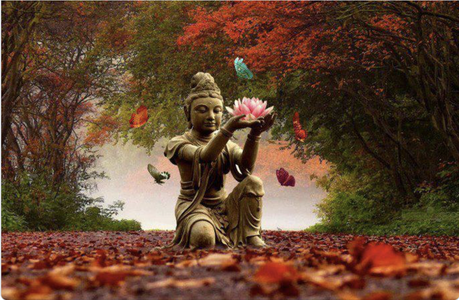 How are you doing? One of the best ways to bring self-care into your life is to check-in with the following five elements. 1. PHYSICAL - Are you getting enough sleep. Are you eating nutrient-rich fresh food? Are you exercising daily? 2. EMOTIONAL - Do you have outlets to process your feelings and emotions. Do you have a framework for self-reflection - journaling/therapy/friends you can confide in? 3. SPIRITUAL - Do you set aside time for regular meditation and contemplation. Do you attend retreats, seminars or courses in this context? 4. RELATIONAL - Do you cultivate deep connections with friends, family or loved ones? Are you building and nurturing community in your life? 5. ATTITUDINAL - Do you try to see things from other people's perspectives. Do you try to always see the positive side. When we allow ourselves to reflect on these five elements of self-care, we learn to bring them into our daily routines, permitting ourselves to create a solid foundation for living a rich & meaningful life. One filled with purpose & meaning. Start with working on one element one day at a time. Then focus on two elements for a few days, and so on... Life is a journey. We are all working together to bring joy into our lives and into the lives of others.
2 Comments
1. Work Up to It If you’re not used to an extended practice, I recommend trying different sets of Sun Salutations varying the lengths before trying 108. For example, start by doing 20 in a row, maybe before or after your regular yoga class, and then work up to 40 or 60. 2. Hydrate! Just like with a hot yoga class, or any other strenuous exercise, the most important thing is to hydrate! Both on the day before and the day of, and during the practice. 3. Take Breaks Take a breather every so often to make sure you’re staying safe. Sun Salutations require a lot of up and down movements, so it’s easy to get lightheaded. Make sure you’re listening to your body and resting in child's pose whenever needed. When in child's pose focus on the humility and gratitude of the practice, and reconnect with your intention. And speaking of which… 4. Hold Onto Your Mantra You can use this practice as a full-body Mala if you’d like; which means that with every Sun Salutation you complete, you’re moving with an intention, whether it’s a word, a phrase, or just a feeling. For example, with each inhaling movement you may focus on breathing in "thanks and joy", and with every exhale you may focus on breathing away "anxiety and hate". This ia just one example—the options are endless, and choosing something that’s right for you to focus on can be an incredibly healing experience. Use your breath to focus on your mantra, and try to let it be the only thing that fills your head as you move. It’s easy to get distracted in a repetitive practice like this, so it’s a great challenge to stay focused and meditative the whole time. Since it’s the same asana over and over, you’re not thinking about the next pose or grappling with a new transition, so you get this wonderful opportunity to focus just on your breathing, your mantra, and your body. 5. Take Some Time Afterward Physically and emotionally, you will need to wind down after this practice. I would recommend doing whatever feels best for your body, and include twisting, happy baby, and stretches for the hips & shoulders before moving into Savasana. I recommend sealing this practice with a two minute seated or supine meditative position, to reflect on what the experience has brought to you. It's important to check in and see how you're doing emotionally before heading straight out into the outside world again. Hopefully these tips will help you feel more prepared for what might seem like a daunting or scary practice, but which is actually incredibly rewarding and exciting experience! Namaste... Special thanks to Maren Hunsberger for her guidance. 3/6/2020 6 Comments Meditation....5 minutes a day can change your attitude, your outlook...and your life!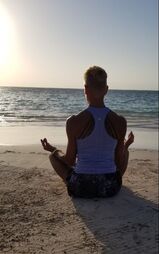 If you take a few minutes each day to meditate, it will make you happier & more productive.....even at at work! Here's 5 meditation techniques you can try. 1. Body Awareness Meditation (5–10 minutes) This meditation is relaxing and helps you to focus awareness on your body instead of the million other thoughts you have every day. It can be performed sitting or lying down.
2. So Hum Mantra Meditation This is a calming mantra meditation that is accompanied by the breath. It can be performed in a seated position in whatever time you have available.
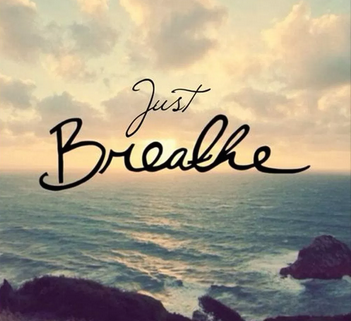 One of the most common ways to assist your meditation practice is to stay focused on your breath. When we are focused on breath, the mind is directed to visualize the flow of energy in and out of the body. Other ways to help you stay in your meditative state might be to repeat a mantra, or embrace the smell of incense or essence oils, or observe the flicker of a candle. When we meditate in this way, we are focusing our awareness on the sensations of a particular experience. In doing so, there becomes a clear connection with life that flows. This, ironically gives us both a point of focus (and a place to return to when our minds wander), and also an understanding of the ever-unfolding process that we call "the present". When we don't have something specific to focus on, our minds will typically attempt to fill the void and introduce thoughts into our experience. This is where the breath comes into play. Given the fact that our minds will tend to wander, the breath can be used as an anchor in the present moment. The breath is always there and is always changing. When we notice that we are lost in thought, at that moment we are free to redirect our awareness back to a broader sense of the present, simply by reconnecting with the breath. When we reconnect with the breath, we bring energy into our mind and into our body. The more we exist in our body, the more we are able to experience the fullness of life. Another benefit of connecting with the breath is that it provides a physical release of energy out of our bodies. Exhalation is the most common way we let go of energy, both emotional and physical. The breath reminds us of the freedom that letting go provides, returning us to a more natural state of being. When we meditate the breath can serve as an anchor, reconnecting us to the flow of life. Once we have reestablished the connection of the flow of breath, we are then welcome to let go and settle back in to noticing the flow of all sensations. Regardless of the style of meditation you are engaged in, the breath can greatly aid your practice and enhance your experience. Namaste, Barb Reference: excerpts from About Meditation, 2017 , Your Breath is a Powerful Ally, David Eyerman So today is the first day back to school, and for me it's one full year of retirement! As I look back on the past 12 months it's been a whirlwind of gifts. Teaching Physical Education at the high-school level for over 27 years was a dream come true, and not an easy decision to retire from. This past year has allowed me to pursue my passion of travel, fitness & yoga, and more importantly it has given me time to learn, explore and give back. Since retiring I've taught more fitness & yoga classes than ever before, and I've enjoyed travelling around the globe. Cruising through Asia Pacific, spending time in HongKong, Vietnam & Taiwan. Amsterdam & cruising the Rhine through Holland, France & Germany. Traveled through the Alps by train revisiting Switzerland & Austria; fell in love with Innsbruck (5 days in Vienna was not enough), forever in my memories a bicycle tour through the Wachau Valley along the Danube River, exploring the Czech Republic, and magical Prague & Budapest. So much fun teaching yoga at resorts in the Mayan Riviera, Cancun, Los Cabos, Tulum and Punta Cana, weekend get-aways in Chicago, Gatineau & Toronto. Spending time with my mum & sister on beautiful Vancouver Island. Organizing our incredible 7-night family reunion in the Algarve, playing in Luz, Lisbon, Sintra and Portugal's coast. Embracing the Greek Islands of Santorini & Crete. Planning & co-hosting an amazing Austrian hiking-yoga retreat, planning a second yoga retreat in Puerto Vallarta this November. Yes - all of this since retirement! In addition I had time to connect with friends, time to garden, renovate, read, time to grow, listen, laugh and reflect. Retirement has been more than I could ever imagine. If you are on the fence about retirement or job change - just do it. Life is an adventure! #yourplan #livinthedream #lovelife #buildyourdream #retirementlife
Barb King 4/10/2018 1 Comment Taking yoga beyond your mat!Below is some helpful information, and an explanation on the eight limbs of yoga. As you may or may not know your yoga practice is much more than the physical postures (asana). Once you've been on the mat for a while, your practice will start to take on an additional purpose as the principles of yoga become your thoughts, words and actions.
The "Eight Limbs of Yoga" listed below can serve as a guide for living a meaningful and purposeful life. 1. YAMAS are ethical considerations to help guide interactions with others
2. NIYAMAS are practices that inform self-discipline and worldview.
3. ASANA refers to the physical postures practiced in yoga.
4. PRANAYAMA refers to breathing.
5. PRATYAHARA is the practice of withdrawing from external stimuli to enhance internal awareness.
6. DHARANA is the practice of intense concentration.
7. DHYANA is the state of being keenly aware, yet without focus.
8. SAMADHI is a state of ecstasy.
https://www.gaia.com/lp/content/the-8-limbs-of-yoga-explained 12/3/2017 4 Comments Why do Hot Yoga?It was a snowy winter day in February, 2003, I was looking forward to trying hot yoga for the first time at Moksha Yoga in downtown London, ON. I remember enjoying and embracing the warmth of the cozy studio while periodically gazing through the small upper windows watching snowflakes fall. The entire experience was wonderful. It was the feeling after class I was not prepared for. At first I felt refreshed, and my body seemed rejuvenated as I floated out of the studio. (I was well prepared and knew to hydrate before, during and after class, so dehydration would not be a problem.) but for the rest of that day and even into the following day I felt exhausted and depleted of energy. I could not understand why so much energy was taken from me, and wondered why anyone would want to “exercise in a sauna”. Hot yoga, I decided was not for me, and not something I would add to my yoga portfolio.
Fast-forward to a few years later - my present employer added a hot yoga studio into the club I was teaching at, and naturally I was encouraged to train for heated yoga. I struggled with the idea of training for something my body originally rejected, but decided to go ahead with it anyway. So glad I gave hot yoga another chance! My body had to learn to “acclimatize” to the heat. (Much like climbing Machu Picchu, we arrived for 5 days prior to get used to the altitude.) Well, our body needs to learn to embrace movement in warm temperatures in the same way. Now I love how I feel after teaching or taking a hot yoga class. It truly is a unique experience; a natural high that I will admit is a little addictive. If your first hot yoga experience was not what you expected, I encourage you to try another class. Here are a few reasons why you should give hot yoga a try: Detoxifies the body One of the benefits of hot yoga is the detoxifying effect sweating has. It feels so good to sweat out of every pore of your body. You leave class feeling clean and refreshed. It’s like pressing a reset button. Even in unheated practice some poses facilitate the body’s natural detoxification process. Releases stress Whatever issues you are dealing with at work, at home, or any other area of your life, you will feel better about them after sweating it out in the hot room. It helps put things in perspective as well as allows you to clear your mind to help you find your next step. Helps weight loss – natural weight The intensified cardiovascular benefit of practicing in the heat increases the weight loss that can come directly from a yoga practice, but perhaps more significant is the shift in motivation that often occurs when people develop a regular yoga practice and start to want to eat healthier foods. Over time the physical effect of the exercise and the effect of healthier choices can lead to significant weight loss for some practitioners. Increases flexibility A lot of people think that only flexible people can do yoga; and it’s likely true that flexibility is above average in most yoga studios, but those people are more flexible because of their practice….meaning you have to start somewhere! Hello - using inflexibility as an excuse not to do yoga is as silly as using hunger as an excuse not to eat! In a heated room your body comfortably starts to let go and the flexibility magically increases. Still not convinced to try hot yoga; simply add in the many benefits of non-heated yoga. Develops mindfulness Living in the moment is something all of us can get better at. Appreciating what is going on right now, and not worrying about the past or the future. Yoga helps us practice this present state of mind. Increases self-esteem Yoga makes you feel good, in many ways. This means feeling great about yourself! Taking care of your body, mind and soul all at once by practicing hot yoga does wonders for how you feel about yourself and life in general. Increases energy No matter how tired and lethargic you feel when you go into a yoga class, you will come out feeling energized and ready to tackle any task. And if it is a night class and that task happens to be going home to sleep, you will wake up energized and ready to seize the day. Increases strength Yoga will help you develop that perfect balance of strength, endurance and flexibility. Strength that allows you to do more things with ease, and improved posture and stability. Strength that leaves you feeling great after class. Strength that develops both the upper and lower body, and the core. Improves mood Feeling down? Yoga is an excellent way to boost your mood and put a smile on your face. A regular yoga practice is the best way to bring good vibes into your life. Increases productivity Post yoga is a great time to get work done that you’ve been putting off. Yoga allows you to leave class with a high level of motivation and confidence, which makes your post yoga time incredibly productive. Try it out next time and get those things done you’ve been procrastinating about. Community and networking Yoga studios are often very warm and welcoming communities filled with an array of people from all walks of life. When such a diverse group come together in one place to move with breath, it creates an incredibly positive and powerful energy. Exploring community is just one of many side benefits of a regular yoga practice. Please check with your doctor to see if you are a good candidate for hot yoga. Feel free to contact me for more information or to try a free class. You should not do hot yoga if you are pregnant, or have high-blood pressure. Namaste, Barb reference: 12 benefits of hot yoga www.healthishappiness.com Mindful Living. What the Heck is That? Katie Wright. September 27, 2017
We hear it a lot. Be mindful. Honour yourself mindfully. What does mindful mean? How do I add that to my to-do list when I’ve already got a bunch of sh*t to do! Well for starters, mindful living is not an actionable item – you can’t cross it off a to-do list. Instead, it’s a way of going about your action items. Here’s how I see it ... Being mindful is about 1) stopping your actions to check-in with your WHOLE self (that means your body, mind, and spirit), 2) aligning with your heart (what your heart wants), and 3) using your check-in and alignment as an arrow to point you forward. That was a lot of words. Let me share an example. How do you stay mindful in the hustle of your job? Feelings of overwhelm and anxiety can creep in – there’s so much to do! Mindful living is stopping the bustle and checking-in with your whole self. Acknowledge that your mind is distraught, your body is tight, your spirit is edgy. Then, and here’s the rich stuff, you anchor to your beloved heart and consciously (aka mindfully) choose what’s important to you. Connect with what your heart and soul crave, and determine what you will do next. Let’s further explore ... How do we stay “present” when we have to-do lists, demands, actions to move our life forward, mouths to feed, children to pay attention to, partners to tune into, meals to plan, etc. etc. Well .... Pause. Pause some more. Breathe. Inhale. Exhale. Breathe some more. How am I feeling right now? Anchor to your heart, and ask yourself this very important question: What is important? What is important for me, the whole me: my body, mind & spirit? Try this: Pause and breathe. What is important to you? Check-in with yourself. Once your pause is over, and you are ready to return from reflection, answer this: what did you discover?
Either option is a fine one because you’ve taken a moment to acknowledge your now, and are consciously moving forward with intentional purpose that came from your heart. If you choose the latter (#2), then bask in this area of love. Breathe it all in. This is a beautiful opportunity to connect to something you love. This allows you to sink into some resonance that your heart is craving. Honouring what is important to you. This place breeds satisfaction, fulfillment, joy ... all those good things. It also breeds the law of attraction. Your thoughts become your experiences. What you put out into the world comes right back at you. You put out love; you get love back. Boomerang. Ex. if you choose to tune love to your partner, your partner is likely to show love right back to you. Maybe this comes in the form of an acknowledgement or affection. Try it on.. play with it. Nothing to lose. So, what about staying mindful when you’re a small business owner and the demands of everyday life exist? Well, it’s about connecting to your heart. What do you want? What is important? Define a plan on how you can accomplish both work and personal. Set goals, set boundaries. Personally, I choose to focus really hard on work for a period of time, and then outside of that time I give myself permission to focus on what I love, whether that be my family, exercise, or making time for myself. It’s about living with mindful, intentional purpose. Anchoring to your heart. Checking out to check-in. Executing on what’s important. Try this on, and enjoy with deep gratification. Live rich. With love, Katie Try on coaching with a 30-minute sample session. Your riches await. Send an email to schedule your date: [email protected] 6/26/2017 3 Comments Yoga - So much more than Asana! When thinking back to my first yoga class, I recall the wonderful way it made me feel. Who knew this new found empowerment would become such a big part of my life! Yoga is a physical, mental and spiritual practice which originated in India, and is enjoyed around the world. It is practiced regularly throughout the continent of Asia, and over the last twenty years, yoga's popularity has exploded throughout North America. A regular practice can have a profound change in thinking and attitude, in addition to providing the many physical benefits. The primary focus of most yoga classes is to improve flexibility and strength (asana), but the physical practice is just one aspect of yoga! Yoga also includes breathing exercises (pranayama), chanting, meditation, yamas (the attitude we have towards others), and niyamas (how we relate to ourselves inwardly). Yoga is your personal & spiritual journey, one which helps you unite with the Self. A regular yoga practice can take you to a state of self-realization, which ultimately allows you to experience inner peace. Most people are initially attracted to the physical aspect of yoga, but with continued practice they realize that it goes well beyond the physical. The philosophy of yoga allows you to naturally start on your own spiritual yoga journey. When you discover your Self through yogic practices, a natural deep awareness is experienced. If you observe and study your mind, you will notice that your thoughts are either about the future or the past. Most of our issues and problems arise from our incapacity to transcend these constant thoughts. Through practice we learn to become more enlightened in our way of thinking. Yoga teaches us to be more mindful about what is happening in the "now" without judgment, and to embrace our experience in the present. We are attached to our physical body; it is our body that takes us through life and towards immortality. Only when we fulfill our physical needs, can we start looking beyond. Yoga is not a religion; it's the science that helps control the mind. In order to progress in our personal yoga practice, we need to start with our mind. Through deep breathing and mindfulness, we control our mind. Embrace your practice with mindfulness, breath and enjoyment. Namaste….. Barb In the months ahead check for future blogs on stress reduction, and how to awaken your vitality! References: "Proof that Yoga is so much more than Asanas" via Elephant Journal - www.elephantjournal.com "Yoga is more than Asanas" via Speaking Tree - www.speakingtree.in/article/yogismorethanasanas |
AuthorBarb is married and lives in London, Ontario. She has two wonderful step-daughters and two amazing step-grand daughters. Barb enjoys travelling and seeks out UNESCO World Heritage destinations around the globe. The history, culture & people she encounters along the way inspires her optimistic attitude and outlook on life. Categories |
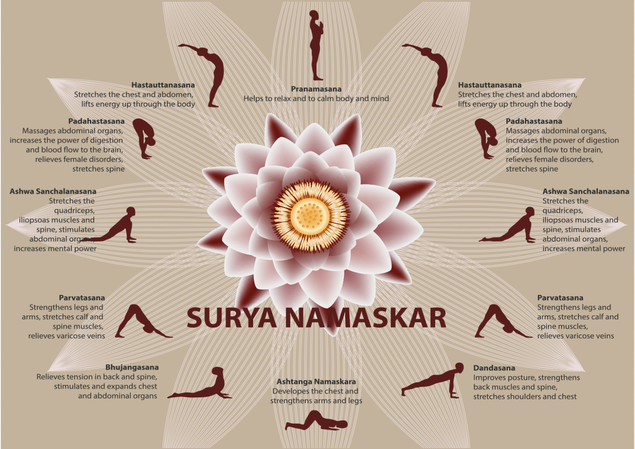

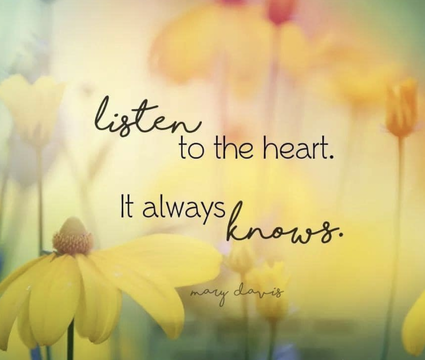
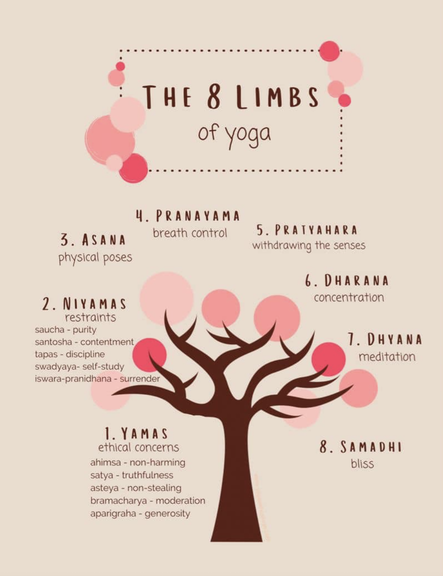
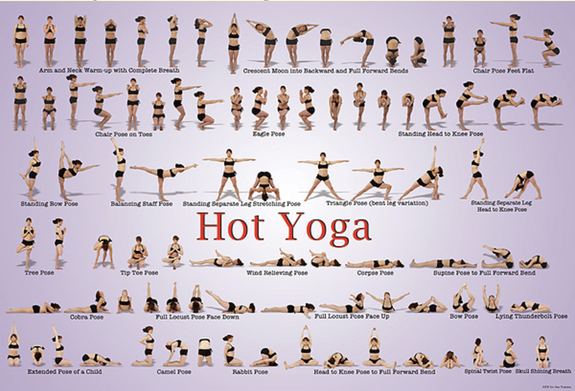
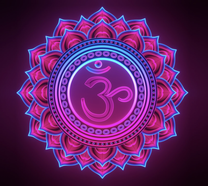

 RSS Feed
RSS Feed
